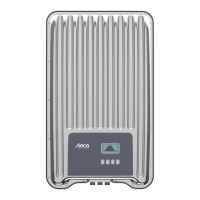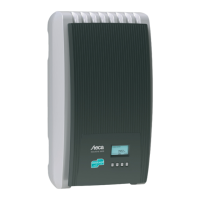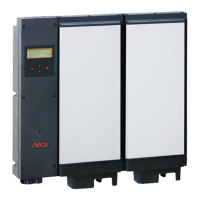Do you have a question about the Steca Fronius Solarix 400 I and is the answer not in the manual?
Covers intended use, risks from voltage, current, accumulators, and informal precautions.
Specifies requirements for the installation location to ensure safety and prevent hazards.
Details recommended procedures for keeping the appliance in good condition and handling malfunctions.
Covers CE labelling requirements and outlines the terms and conditions of the product warranty.
Describes the appliance's integrated design, housing, and quality assurance for reliability.
Explains the function of the stand-alone inverter, its output voltage, and consumer compatibility.
Details the charge regulator's role in battery management, including SOC, overcharge, and temperature tracking.
Lists typical uses for the Solarix, highlighting features for camping and leisure, and island systems.
Outlines built-in safety features like short-circuit, overload, overtemperature, and low voltage protection.
Explains the meaning of the indicator lamp for the solar charge regulator's operating status.
Details the meaning of the indicator lamp for the stand-alone inverter's operating status.
Describes the information shown on the digital display, including battery status and charging parameters.
Explains how to use the operating mode key to cycle through different operational states.
Details the stand-by mode, its purpose, power saving, and requirements for load detection.
Describes the continuous operation mode where AC power is always available for consumers.
Explains the sleep mode for extended periods without AC voltage, optimizing battery power.
Explains that factory settings are suitable for most applications and configuration is done via jumpers.
Describes how to enable the night-light function for lighting systems, switching consumers automatically.
Details the procedure to change the jumper setting for liquid electrolyte or gel-like electrolyte batteries.
Explains how to set the voltage-controlled charging mode for batteries charged by sources other than solar modules.
Lists necessary conditions for installation, including location, ventilation, and clearances.
Guides on selecting appropriate cables, ensuring proper assembly, and connecting ground wires.
Provides step-by-step instructions for connecting battery cables and solar modules.
Details how to connect AC consumers to the appliance using the provided cable.
Explains how to fasten cables securely below the appliance using strain relief for organization.
Lists error conditions, their causes, consequences, and recommended solutions for the inverter.
Details error messages for the charge regulator and digital display, including causes and remedies.
Illustrates a typical installation setup for the Solarix using protective separation with a wiring diagram.
Covers intended use, risks from voltage, current, accumulators, and informal precautions.
Specifies requirements for the installation location to ensure safety and prevent hazards.
Details recommended procedures for keeping the appliance in good condition and handling malfunctions.
Covers CE labelling requirements and outlines the terms and conditions of the product warranty.
Describes the appliance's integrated design, housing, and quality assurance for reliability.
Explains the function of the stand-alone inverter, its output voltage, and consumer compatibility.
Details the charge regulator's role in battery management, including SOC, overcharge, and temperature tracking.
Lists typical uses for the Solarix, highlighting features for camping and leisure, and island systems.
Outlines built-in safety features like short-circuit, overload, overtemperature, and low voltage protection.
Explains the meaning of the indicator lamp for the solar charge regulator's operating status.
Details the meaning of the indicator lamp for the stand-alone inverter's operating status.
Describes the information shown on the digital display, including battery status and charging parameters.
Explains how to use the operating mode key to cycle through different operational states.
Details the stand-by mode, its purpose, power saving, and requirements for load detection.
Describes the continuous operation mode where AC power is always available for consumers.
Explains the sleep mode for extended periods without AC voltage, optimizing battery power.
Explains that factory settings are suitable for most applications and configuration is done via jumpers.
Describes how to enable the night-light function for lighting systems, switching consumers automatically.
Details the procedure to change the jumper setting for liquid electrolyte or gel-like electrolyte batteries.
Explains how to set the voltage-controlled charging mode for batteries charged by sources other than solar modules.
Lists necessary conditions for installation, including location, ventilation, and clearances.
Guides on selecting appropriate cables, ensuring proper assembly, and connecting ground wires.
Provides step-by-step instructions for connecting battery cables and solar modules.
Details how to connect AC consumers to the appliance using the provided cable.
Explains how to fasten cables securely below the appliance using strain relief for organization.
Lists error conditions, their causes, consequences, and recommended solutions for the inverter.
Details error messages for the charge regulator and digital display, including causes and remedies.
Illustrates a typical installation setup for the Solarix using protective separation with a wiring diagram.












